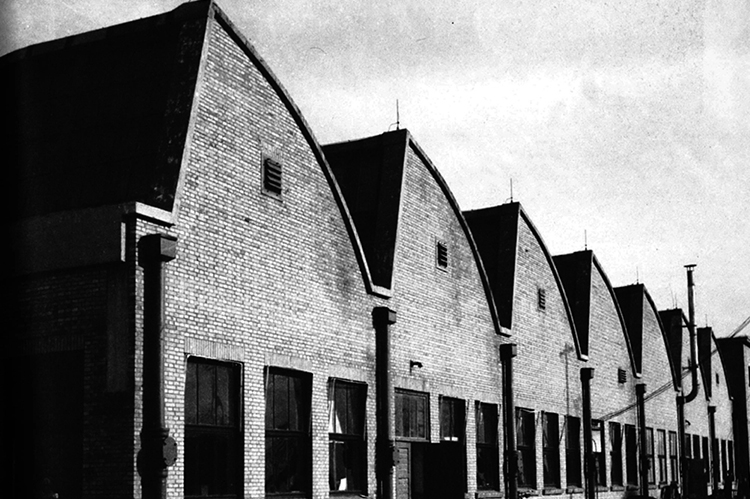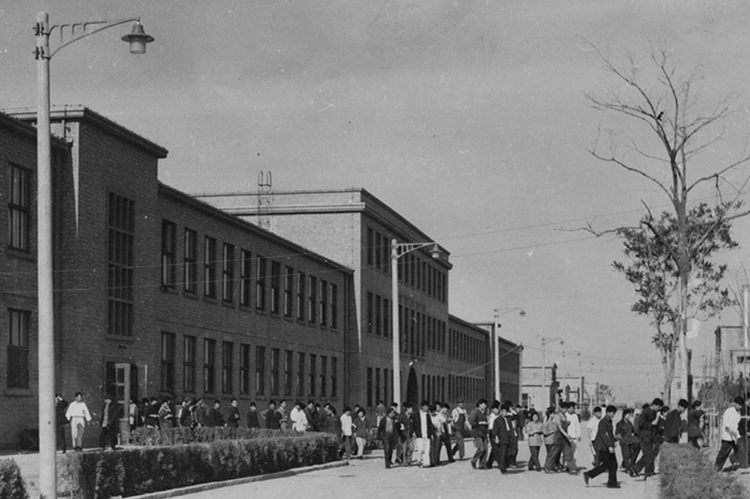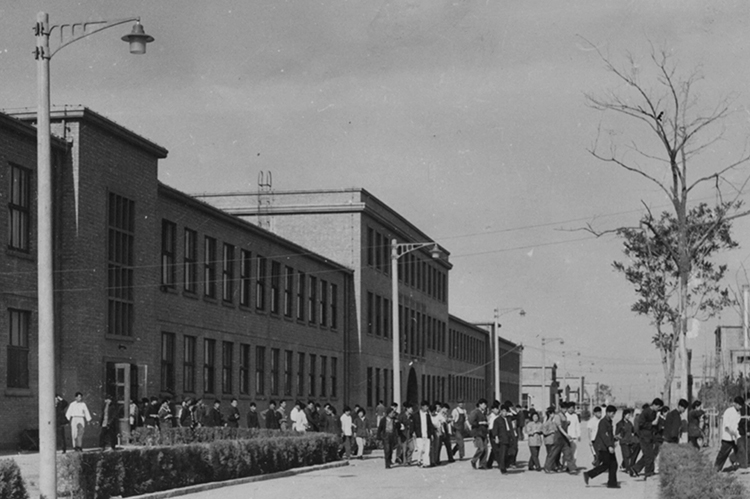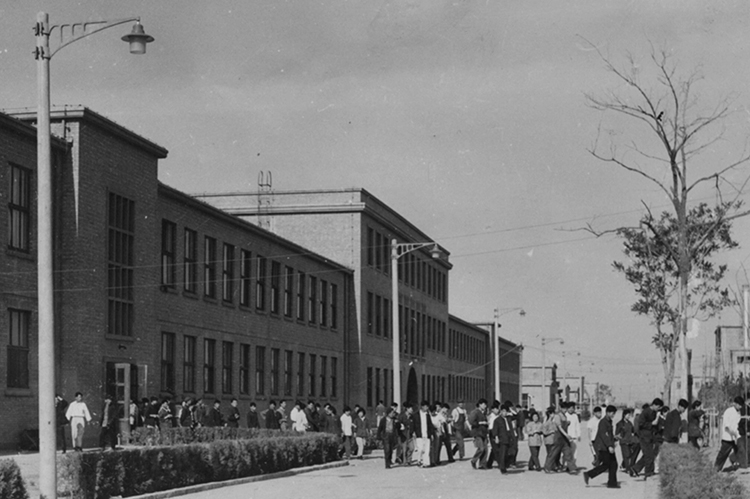

718与包豪斯
718 and Bauhaus
718厂与同期社会主义建筑的区别
50年代中期,社会主义国家阵营的公共建筑受到来自苏联建筑的风格影响,718联合厂的建设时期正好处在斯大林时期末端,这个时期的建筑设计是最自负的,它的理论源于1932年联共中央通过取消文艺派别,建立统一的创作联盟的决议,并取消了各种建筑派别,规定社会主义现实主义是文学、艺术、包括建筑的创作方法。俄罗斯古典主义作为民族形式,从公共建筑到大量住宅,从高层建筑到地下车站,被广泛采用。这种理论认为:应该吸取人类建筑史上一切不朽的精华,古希腊的、古罗马的、古俄罗斯和东方的,并且应该给这些经受住漫长时间考验的艺术形式注入新的社会主义内容。这个时期的苏联建筑有明显的特征,即庄重,宏伟,高大方正。
建国初期苏联建筑风格的影响
当时在社会主义大家庭中,不止是在建筑的建造技术上苏联专家要给予指导,建筑的形象上也是遵从苏联专家的意见。许多公共建筑都是苏联时期建筑的缩小版,例如1954年建的北京展览馆就是典型的中国苏式建筑,苏联原版的还要更大,更宏伟。当然在这个时期我国也出现很多折衷主义建筑,即将斯大林时期的建筑与本土政治文化符号相结合的建筑形态。例如哈尔滨医科大学,华东师范大学等建筑。
718联合厂的建筑设计
718联合厂的建筑设计当时由东德的德绍设计院完成,与德绍设计院不谋而合的是包豪斯大学最辉煌时期曾在德绍建立校舍并展开教学。其教学理念在德绍及整个德国有深远的传播,很多人认为包豪斯形成了自己定式的建筑风格,但它其实是一种包豪斯思想,建筑的风格不过是一个时期的产物。
追溯这个思想的形成,可最早到19世纪中后期以及20世纪初年的德国工业革命背景下的现代设计启蒙思想。随着德国完成了土地改革和工业社会的转变,许多新兴的工业城市和大型的工厂以及大量的工人在德国各地出现。而随着工业社会的发展,人们的生产生活也随之呼唤新型的建筑与造型设计思想的出现。在包豪斯诞生之前就已经出现德意志制造联盟(Deutsch Werkbund,简称DWB)。DWB主要协调建筑师和造型艺术等专业人士与工业企业以及社会人群需要之间的关系。
包豪斯的创始人格罗皮乌斯1910年加入了德意志制造联盟(Deutschen Werkbund)。1912年,他组织设计了法古斯特厂厂房,其中他第一次运用了综合设计的理念,把建筑设计、室内设计、立面设计以及厂房机械设计统一考虑,成为当时运用大玻璃幕和钢铁构架的现代建筑代表。他认为工厂建筑的环境包含着许多复杂的因素,但它仍然是人的思想与意志的外观,它不仅表现为“刺激—反应”的关系,同时也是一种“创造—适应—再创造”的关系。厂房的设计不仅要考虑到实用,更要考虑到建筑立面装饰和室内装饰美感,这些因素都在调节人的劳动情绪,焕发人的积极精神,使人感到劳动中的愉快,从而提高生产效能。这种厂房建筑设计的观念为未来718联合厂的锯齿厂房设计奠定了人性化设计的思想基础。
包豪斯在格罗皮乌斯时期确立了调和美术和工业化社会之间的方向。力图探索艺术与技术的新统一,并要求设计师“向死的机械产品注入灵魂”。只有推敲出最卓越的想法才能证明工业的倍增是正当的。在设计理论上,包豪斯提出了三个基本观点:①艺术与技术的新统一:②设计的目的是人而不是产品:③设计必须遵循自然与客观的法则来进行。这些观点对于设计的发展起到了积极的作用,使现代设计逐步由理想主义走向现实主义,即用理性的、科学的思想来代替艺术上的自我表现和浪漫主义。
两大对立的设计思想
从二战后到70年代,包豪斯引领的现代主义设计思想在全世界蓬勃发展。这一时期,西欧和美国以及日本都相继在战后的大建设时期掀起了以现代主义主导的建设浪潮,这股浪潮在50年代后期甚至被命名为“国际主义风”。这种“国际主义风”虽然与二战前欧洲的“现代主义思想”同宗同源,但由于受到了当时以美国为首的“国际主义”思想的影响,在思想意识和形式手法上显然有所背离。在这样的“国际主义风”的设计思想主导下,欧美资本主义阵营国家纷纷效仿。同时社会主义国家苏联也开始了战后的大建设,秉承建筑传统,并出于刻意与欧美资本主义阵营“国际主义风”相对抗的目的,苏联确立了古典复兴和民族主义混合的“折中主义”建筑风格。这种折中主义强调形式与象征意义第一、功能与使用第二,由此造就了苏联二战后20年中大批体量宏大、造价高昂、功能性很差的公共建筑。苏联把欧美国家在此期间广泛发展的“国际主义风”建筑视为腐朽的资本主义制度的象征,从根本上否定国际主义风格以及它的源头“现代主义”和“包豪斯”设计思想,禁止与当时由现代主义衍生出来的一系列流派,包括典雅主义、粗野主义、有机功能主义、高技术派等进行学习与交流。
新中国在建立初期受苏联的影响,效仿苏联建造了一大批“折中主义”大型公共建筑,这些在中国建设的折中主义公共建筑,往往体量庞大并带有繁琐的装饰柱式和复古的立面,却缺乏实用的功能和经济节约的考虑。
但是718联合厂(798艺术区的前身)却得以幸免,首任总工程师罗沛霖回忆718筹备过程时候说:
“联合厂的建筑设计是在柏林有了总体规划以后,委托德国的建筑师设计的。当时苏联正在批判火柴盒式的现代主义建筑,主张艺术性和技术的结合,他们的建筑加了民族装饰,很美观,当然也很花钱。出于可以理解的谨慎情绪,德方专家曾提议在中央办公楼的设计上或参考苏联人的风格,可以盖得有些民族形式,像宫殿那样。我说别讲我们的民族形式,我都不知道我们的建筑以后会走什么路子,你们还是按照你们通常的设计做,怎么搞合理就怎么搞吧。因此,也就有了后来和苏联那一套完全不同的设计。”
On the Difference between 718 Factory and its Contemporary Socialist Architecture
In the mid 1950s, the design of public buildings in the socialist camp was very much influenced by Soviet architecture. 718 Joint Factory broke ground at the end of Stalin era. The buildings of the period were absolutely self-referential based on Central Committee of the Communist Party’s decree to disband all existing artistic community and replace them with artist unions. The architectural communities were also broken up. Social Realism was the answer to all literary, artistic and architectural inquiries. Russian Classical architecture was adopted as national expression. It was applied widely from public buildings to residential units, from high-rises to underground train stations, all coming from the same principle——taking the essence of architecture history of all mankind, no matter ancient Greek and Roman, ancient Russia or Eastern, reviving those that stood the test of time with fresh socialist energy. Soviet architecture of this period was particularly ceremonial, imposing and solid.
Reference to Soviet Architecture in the Early Years of the New China
Back then among the Socialist countries, professionals from the Soviet Union not only instructed construction techniques but also gave advice on visual forms. Many of the public buildings at the time were scaled-down versions of those in the Soviet Union. Beijing Exhibition Hall is a typical example of Chinese take on one Soviet architecture, which was bigger and more imposing. That being said, there also emerged a number of Eclectic Architectures, collaging styles of Stalin ear with local sociopolitical symbols. Examples include Harbin Medical University campus and East China Normal University campus.
The Design of 718 Joint Factory
The building of 718 Joint Factory was designed by Dessau Institute of Architecture from the former DDR. Both Dessau-based institutes, Bauhaus also set up its campus and programs here in its golden days, bringing Bauhaus idea to Dessau then across Germany. Many consider Bauhaus as the cradle of an architecture style, but in fact, it’s more about the philosophy behind the forms since “style” is only a product of a section of history.
The origin of Bauhaus idea can be traced back to late 19th and early 20th century when modern enlightenment in the field of design emerged from German industrial revolution. With land-reform and the transition to an industrial society, industrial cities and major factory plants began to take their places across Germany, housing a large number of workers. A growing industrial society called for new ideas on building and forms to accommodate new modes of production and living. Before Bauhaus, there was Deutscher Werkbund (DWB). It focused on coordinating the ideas from professional architects and makers with the needs from general public.
The founder of Bauhaus, Walter Gropius joined Deutscher Werkbund in 1910. In 1912, he led the design team for Fagus Factory in Alfeld, applying his concept of integrated design in physical forms for the first time. He considers architecture design, interior design, facade and factory equipment as one integrated unity. This building was later regarded as distinctive modern architecture with glass facade and steel structure. Gropius acknowledges the complicated context of factory building, yet he believes it should still manifest Man’s will and thinking, express the “stimulus-response” relationship and the “create-adjust-recreate” cycle. The design of factory workshops needs to be not only practical but also beautiful in terms of facade and interior deco, all together affect worker’s attitudes towards their labor, evoke positive energy and pleasure, which all lead to greater productivity. This philosophy towards factory design is the conceptual base for the worker-friendly sawing workshop in 718 Joint Factory.
During Gropius days, Bauhaus set its goal to bring together art and industry, and began searching for new possibility to integrate art and technology. They ask designers to “breathe a soul into the dead product of the machine” and believe that only the most outstanding idea can validate the exponential growth of production. As to its design theory, Bauhaus put forward three fundamental ideas:
1. Art and Technology-A New Unity
2. Design for man instead of machine
3. Nature teaches the way we should design
These ideas pushed the field of design forward, saving modern design from utopia to realism, substituting individual artistic expression and romanticism with rational and scientific set of mind.
Two Opposing Minds
From WWII to 1970s, modern design led by Bauhaus had spread and flourished around the world. A new wave of modern building construction reached West Europe, the United States and Japan. It was even given the name “International Style” in the late 1950s, which shared the same root with “Modernism” evolved in Europe before “the Big One”. Since “International Style” was nurtured by “Internationalism” endorsed by the U.S., its mentality and forms clearly deviated from the original branch. European capitalists camp took shade in the shadow of International Style while the core member of the socialist camp, the Soviet Union, took on its own post-war reconstruction. They inherited the architectural tradition and were meant to stand against the prevailing style of its opponent. The Soviet Union proposed “Eclecticism” that combined classical revival and nationalist approach. It specifically hailed formalism and symbolism over function and utility, thus a series of gigantic, overly expensive and unpractical public architecture were built in the first 20 years after WWII. The International Style that had developed drastically in the Western world was considered by the Soviet Union a signifier of corrupted capitalism. Due to complete rejection of the style and its root in Modernism and Bauhaus philosophy, other school of ideas derived from the same origin were simultaneously prohibited by the union, including Neo-Classicism, Brutalism, Organic Functionalism and High-Tech.
In the first few years of the New China, under the influence of Soviet Union, a great number of “Eclectic” large-scale public architecture was constructed. These versions are usually huge in scale, adorned with lavish orders and facade in revival style, all uneconomical and are lack of practical function.
However, 718 Joint Factory (now 798 Art District) was an exception. The first chief engineer Luo Peilin (罗沛霖) recalled when they started the project:
“We commissioned German architects to design the project. By the time the city plan for Berlin was already established while the Soviet was criticizing ‘those modern match-boxes’. They weighted more on the artistic side despite the combination with technology so they adorned the buildings with traditional patterns. Visually they were really pleasant but they cost quite much. Out of attentive concern and understanding, the German team first suggested bringing some elements from the Soviet style to the central office building, something that spoke to our national tradition, maybe a palace shape. I told them to leave the so called national style alone because no one had any clear idea about how the future architecture might be. I asked them to please take the lead and do whatever they believed to make sense. Then here we have a completely different design from the Soviet style.”



